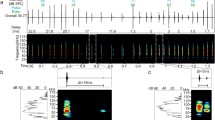Summary
The rufous horseshoe bat, Rhinolophus rouxi, was trained to discriminate differences in target distance. Loud free running artificial pulses, simulating the bat's natural long-CF/FM echolocation sounds, interfered with the ability of the bat to discriminate target distance. Interference occurred when the duration of the CF component of the CF/FM artificial pulse was between 2 and 70 ms. A brief (2.0 ms) CF signal 2–68 ms before an isolated FM signal was as effective as a continuous CF component of the same duration. When coupled with the bat's own emissions, a 2 ms FM sweep alone was effective in interfering when it came 42 to 69 ms after the onset of the bat's pulse. The coupled FM artificial pulses did not interfere when they began during the bat's own emissions.
It appears that the onset of the CF component activates a gating mechanism that establishes a time window during which FM component signals must occur for proper neural processing. A comparison with a similar gating mechanism in Noctillo albiventris, which emits short-CF/FM echolocation sounds, reveals that the temporal parameters of the time window of the gating mechanism are species specific and specified by the temporal structure of the echolocation sound pattern of each species.
Similar content being viewed by others
Abbreviations
- FM :
-
frequency modulated
- CF :
-
constant frequency
References
Feng AS, Simmons JA, Kick SA (1978) Echo detection and target ranging neurons in the auditory system of the bat Eptesicus fuscus. Science 202:645–648
Gellerman LW (1933) Chance disorders of alternating stimuli in visual discrimination experiments. J Genet Psychol 42:205–208
Grinnell AD (1963) The neurophysiology of audition in bats: Temporal parameters. J Physiol (Lond) 167:67–96
Grinnell AD (1973) Neural processing mechanisms in echolocating bats, correlated with differences in emitted sounds. J Acoust Soc Am 54:147–156
Grinnell AD, Griffin DR (1958) The sensitivity of echolocation in bats. Biol Bull 114:10–22
Henson OW Jr (1965) The activity and function of the middle ear muscles in echolocating bats. J Physiol (Lond) 180:871–887
Henson OW Jr (1967) The perception and analysis of biosonar signals by bats. In: Busnel RG (ed) Animal sonar systems. Lab Physiol Acoust, Jouy-en-Josas, France, pp 949–1003
Kick SA (1982) Target-detection by the echolocating bat, Eptesicus fuscus. J Comp Physiol 145:431–435
Neuweiler G, Metzner W, Heilmann U, Rübsamen R, Eckrich M, Costa HH (1987) Foraging behavior and echolocation in the rufous horseshoe bat (Rhinolophus rouxi) of Sri Lanka. Behav Ecol Sociobiol 20:53–67
Novick A (1977) Acoustic orientation. In: Wimsatt WA (ed) Biology of bats, vol 3. Academic Press, New York, pp 74–289
O'Neill WE, Suga N (1979) Target range-sensitive neurons in the auditory cortex of the mustached bat. Science 203:69–73
O'Neill WE, Suga N (1982) Encoding of target range information and its representation in the auditory cortex of the mustached bat. J Neurosci 2:17–31
Pollak GA, Marsh D, Bodenhamer R, Southers H (1977) Characteristics of phasic-on neurons in inferior colliculus of unanesthetized bats with observations relating to mechanisms of echo ranging. J Neurophysiol 40:926–942
Roverud RC, Grinnell AD (1985a) Discrimination performance and echolocation signal integration requirements for target detection and distance determination in the CF/FM bat, Noctilio albiventris. J Comp Physiol A 156:447–456
Roverud RC, Grinnell AD (1985b) Echolocation sound features processed to provide distance information in the CF/FM bat, Noctilio albiventris: evidence for a gated time window utilizing both CF and FM components. J Comp Physiol A 156:457–469
Schnitzler HU, Henson OW Jr (1980) Performance of airborne animal sonar systems: I. Microchiroptera. In: Busnel RC, Fish JF (eds) Animal sonar systems. Plenum Press, New York, pp 109–181
Skolnik MI (1962) Introduction to radar systems. McGraw-Hill, New York
Suga N (1970) Echo-ranging neurons in the inferior colliculus of bats. Science 170:449–452
Suga N, O'Neill WE (1979) Neural axis representing target range in the auditory cortex of the mustached bat. Science 206:351–353
Suga N, Schlegel P, Shimozawa T, Simmons J (1973) Orientation sounds evoked from echolocating bats by electrical stimulation of the brain. J Acoust Soc Am 54:793–797
Suga N, O'Neill WE, Manabe T (1978) Cortical neurons sensitive to combinations of information-bearing elements of biosonar signals in the mustached bat. Science 200:778–781
Sullivan WE (1982) Neural representation of target distance in auditory cortex of the echolocating bat Myotis lucifugus. J Neurophysiol 48:1011–1032
Woodward PM (1964) Probability and information theory, with applications to radar, 2nd ed. Pergamon Press, New York
Author information
Authors and Affiliations
Rights and permissions
About this article
Cite this article
Roverud, R.C. A gating mechanism for sound pattern recognition is correlated with the temporal structure of echolocation sounds in the rufous horseshoe bat. J Comp Physiol A 166, 243–249 (1989). https://doi.org/10.1007/BF00193468
Accepted:
Issue Date:
DOI: https://doi.org/10.1007/BF00193468



